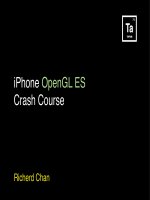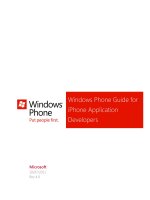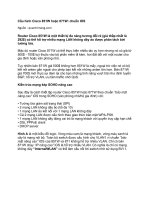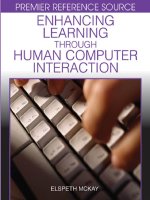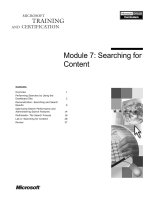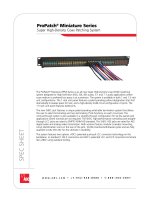Learning OpenGL ES for iOS doc
Bạn đang xem bản rút gọn của tài liệu. Xem và tải ngay bản đầy đủ của tài liệu tại đây (10.03 MB, 352 trang )
ptg8286261
www.it-ebooks.info
ptg8286261
Learning OpenGL
ES for iOS
www.it-ebooks.info
ptg8286261
The Addison-Wesley Learning Series is a collection of hands-on programming
guides that help you quickly learn a new technology or language so you can
apply what you’ve learned right away.
Each title comes with sample code for the application or applications built in
the text. This code is fully annotated and can be reused in your own projects
with no strings attached. Many chapters end with a series of exercises to
encourage you to reexamine what you have just learned, and to tweak or
adjust the code as a way of learning.
Titles in this series take a simple approach: they get you going right away and
leave you with the ability to walk off and build your own application and apply
the language or technology to whatever you are working on.
Visit informit.com/learningseries for a complete list of available publications.
Addison-Wesley Learning Series
www.it-ebooks.info
ptg8286261
Upper Saddle River, NJ • Boston • Indianapolis • San Francisco
New York • Toronto • Montreal • London • Munich • Paris • Madrid
Cape Town • Sydney • Tokyo • Singapore • Mexico City
Learning OpenGL
ES for iOS
A Hands-On Guide to
Modern 3D Graphics Programming
Erik M. Buck
www.it-ebooks.info
ptg8286261
Many of the designations used by manufacturers and sellers to distinguish their products
are claimed as trademarks. Where those designations appear in this book, and the pub-
lisher was aware of a trademark claim, the designations have been printed with initial capi-
tal letters or in all capitals.
The author and publisher have taken care in the preparation of this book, but make no
expressed or implied warranty of any kind and assume no responsibility for errors or omis-
sions. No liability is assumed for incidental or consequential damages in connection with
or arising out of the use of the information or programs contained herein.
The publisher offers excellent discounts on this book when ordered in quantity for bulk
purchases or special sales, which may include electronic versions and/or custom covers
and content particular to your business, training goals, marketing focus, and branding
interests. For more information, please contact:
U.S. Corporate and Government Sales
(800) 382-3419
For sales outside the United States, please contact:
International Sales
Visit us on the Web: informit.com/aw
Library of Congress Cataloging-in-Publication Data is on file.
Copyright © 2013 Pearson Education, Inc.
All rights reserved. Printed in the United States of America. This publication is protected
by copyright, and permission must be obtained from the publisher prior to any prohibited
reproduction, storage in a retrieval system, or transmission in any form or by any means,
electronic, mechanical, photocopying, recording, or likewise. To obtain permission to
use material from this work, please submit a written request to Pearson Education, Inc.,
Permissions Department, One Lake Street, Upper Saddle River, New Jersey 07458, or you
may fax your request to (201) 236-3290.
ISBN-13: 978-0-32-174183-7
ISBN-10: 0-32-174183-8
Text printed in the United States on recycled paper at R.R. Donnelley in Crawfordsville,
Indiana.
First printing, August 2012
Editor-in-Chief
Mark Taub
Acquisitions Editor
Trina MacDonald
Development Editor
Sheri Cain
Managing Editor
Kristy Hart
Project Editor
Andy Beaster
Copy Editor
Paula Lowell
Indexer
Christine Karpeles
Proofreader
Sarah Kearns
Technical
Reviewers
Scott Yelich
Mike Daley
Patrick Burleson
Editorial Assistant
Olivia Basegio
Cover Designer
Chuti Prasertsith
Compositor
Gloria Schurick
www.it-ebooks.info
ptg8286261
v
I dedicate this tome to my beloved wife, Michelle. She is always right in
matters of fact or memory (seriously, never bet against her) and makes
life possible. May her tireless support and understanding bring her just
commendation.
v
www.it-ebooks.info
ptg8286261
Contents at a Glance
Preface x
1 Using Modern Mobile Graphics Hardware 1
2 Making the Hardware Work for You 19
3 Textures 59
4 Shedding Some Light 87
5 Changing Your Point of View 107
6 Animation 133
7 Loading and Using Models 159
8 Special Effects 183
9 Optimization 217
10 Terrain and Picking 237
11 Math Cheat Sheet 277
12 Putting It All Together 303
Index 327
www.it-ebooks.info
ptg8286261
Table of Contents
Preface x
1 Using Modern Mobile Graphics Hardware 1
What Is 3D Rendering? 2
Supplying the Graphics Processor with Data 4
The OpenGL ES Context 9
The Geometry of a 3D Scene 9
Summary 17
2 Making the Hardware Work for You 19
Drawing a Core Animation Layer with OpenGL ES 19
Combining Cocoa Touch with OpenGL ES 22
The OpenGLES_Ch2_1 Example 27
Deep Dive: How Does GLKView Work? 42
Extrapolating from GLKit 51
Summary 58
3 Textures 59
What Is a Texture? 59
The OpenGLES_Ch3_1 Example 65
Deep Dive: How Does GLKTextureLoader Work? 69
The OpenGLES_Ch3_3 Example 76
Opacity, Blending, and Multi-Texturing 77
Texture Compression 84
Summary 85
4 Shedding Some Light 87
Ambient, Diffuse, and Specular Light 88
Calculating How Much Light Hits Each Triangle 90
Using GLKit Lighting 95
The OpenGLES_Ch4_1 Example 97
Bake Lighting into Textures 104
Fragment Operations 105
Summary 106
www.it-ebooks.info
ptg8286261
viii
Contents
5 Changing Your Point of View 107
The Depth Render Buffer 107
The OpenGLES_Ch5_1 and OpenGLES_Ch5_2
Examples 109
Deep Dive: Adding a Depth Buffer Without GLKKit 115
Transformations 117
Transformation Cookbook 129
Perspective and the Viewing Frustum 130
Summary 132
6 Animation 133
Motion Within a Scene: The OpenGLES_Ch6_1
Example 134
Animating Vertex Data 140
Animating Colors and Lights: The OpenGLES_Ch6_3
Example 148
Animating Textures 153
Summary 157
7 Loading and Using Models 159
Modeling Tools and Formats 160
Reading modelplist Files 165
The OpenGLES_Ch7_1 Example 168
Advanced Models 172
Summary 181
8 Special Effects 183
Skybox 183
Deep Dive: How Does GLKSkyboxEffect Work? 186
Particles 199
Billboards 206
Summary 216
9 Optimization 217
Render as Little as Possible 218
Don’t Guess: Profile 232
Minimize Buffer Copying 234
Minimize State Changes 235
Summary 236
www.it-ebooks.info
ptg8286261
ix
Contents
10 Terrain and Picking 237
Terrain Implementation 237
Adding Models 249
OpenGL ES Camera 253
Picking 258
Optimizing 267
Summary 274
11 Math Cheat Sheet 277
Overview 278
Decoding a Matrix 279
Quaternions 296
Surviving Graphics Math 297
Summary 301
12 Putting It All Together 303
Overview 304
Everything All the Time 306
Device Motion 323
Summary 325
Index 327
www.it-ebooks.info
ptg8286261
Preface
OpenGL ES technology underlies the user interface and graphical capabilities exhibited by
Apple’s iOS devices, iPhone, iPod Touch, and iPad. The “ES” stands for Embedded Systems,
and the same technology applies to video game consoles and aircraft cockpit displays, as well
as a wide range of cell phones from almost every manufacturer. OpenGL ES is a subset of the
OpenGL versions used with desktop operating systems. As a result, OpenGL ES applications are
often adaptable to desktop systems, too.
This book introduces modern graphics programming and succinctly explains the effective
uses of OpenGL ES for iOS devices. Numerous example programs demonstrate graphics
programming concepts. The website at hosts the examples,
related articles, and any errata discovered after publication. This book serves as a gentle but
thorough explanation of graphics technology from the lowest-level bit manipulation to
advanced topics.
A significant challenge to learning graphics programming manifests the first time you try to
sort through piles of misleading information and out-of-date examples littering the Internet.
OpenGL started as a small software library for state-of-the-art graphics workstations in 1992.
Graphics hardware improved so much so quickly that handheld devices now outperform
the best systems money could buy when OpenGL was new. As hardware advanced, some of
the compromises and assumptions made by the designers of OpenGL lost relevance. At least
12 different versions of the OpenGL standard exist, and modern OpenGL ES omits support
for many techniques that were common in previous versions. Unfortunately, obsolete code,
suboptimal approaches, and anachronistic practices built up over decades remain high
in Google search results. This book focuses on modern, efficient approaches and avoids
distractions from irrelevant and obsolete practices.
Audience
The audience for this book includes programming students and programmers who are expert in
other disciplines and want to learn about graphics. No prior experience with computer graphics
is required. You do need to be familiar with C or C++ and object-oriented programming
concepts. Prior experience with iOS, the Objective-C programming language, and the Cocoa
Touch frameworks is beneficial but not essential. After finishing this book, you will be ready to
apply advanced computer graphics technology in your iOS applications.
www.it-ebooks.info
ptg8286261
xi
Preface
Example Code
Many of the examples provided in this book serve as a launch point for your own projects.
Computer source code for examples accompanying this book can be downloaded from http://
opengles.cosmicthump.com/learning-opengl-es-sample-code/ under the terms of the permissive
MIT software license: />Examples are built with Apple’s free developer tools, the Objective-C programming language,
and Apple’s Cocoa Touch object-oriented software frameworks. The OpenGL ES Application
Programming Interface (API) consists of American National Standards Institute (ANSI) /
International Organization for Standardization (ISO) C programming language data types
and functions. As a superset of ANSI/ISO C, Objective-C programs natively interact with
OpenGL ES.
Every application for iOS contains at least a small dependence on Apple’s Objective-C–based
Cocoa Touch frameworks. Some developers minimize application integration with Cocoa
Touch by reusing existing libraries of cross-platform code written in C or C++. As a derivative
of UNIX operating systems, iOS includes the standard C libraries and UNIX APIs making it
surprisingly easy to re-host cross-platform code to Apple devices. OpenGL ES itself partly
consists of a cross-platform C library. Nevertheless, in almost every case, developers who shun
Cocoa Touch and Objective-C do themselves a disservice. Apple’s object-oriented frameworks
promote unprecedented programmer productivity. More importantly, Cocoa Touch provides
much of the tight platform integration and polish users expect from iOS applications.
This book embraces Objective-C and Cocoa Touch. Apple’s Objective-C–based GLKit framework
is so compellingly powerful and elegant that it clearly establishes the future direction of
graphics programming. This book could hardly claim to teach modern techniques by avoiding
GLKit and focusing solely on low-level C interfaces to the operating system and OpenGL ES.
Objective-C
Like ANSI/ISO C, Objective-C is a very small language. Experienced C programmers generally
find Objective-C easy to learn in a few hours at most. Objective-C adds minimally to the
C language while enabling an expressive object-oriented programming style. This book
emphasizes graphics programming with descriptions of Objective-C language features provided
as needed. You don’t need to be an Objective-C or Cocoa Touch expert to get started, but you
do need to be familiar with C or C++ and object-oriented programming concepts. You will find
that implementing application logic with Objective-C is easy and elegant. Cocoa Touch often
simplifies application design particularly when responding to user input.
www.it-ebooks.info
ptg8286261
xii
Preface
C++
The ANSI/ISO C++ programming language is not quite a perfect superset of ANSI/ISO C, but it
can almost always be intermixed freely with C. OpenGL ES works seamlessly with C++, and the
OpenGL Architectural Review Board (ARB) guards the OpenGL ES specification to assure future
compatibility with C++.
The C++ programming language is one of the most popular choices for graphics programmers.
However, C++ is a very large programming language replete with idioms and subtlety.
Developing an intermediate mastery of C++ can take many years. Graphics programming with
C++ has advantages. For example, the mathematics used in graphics programs can often be
expressed most succinctly using the C++ operator overloading feature.
There are no obstacles to mixing C++ code with Objective-C. Apple’s developer tools even
support Objective-C++ allowing mixed C++ and Objective-C code within a single statement.
However, Objective-C is the primary programming language for iOS. You’ll find Objective-C in
almost all iOS sample code available from Apple and third parties. C++ is available if you want
it but covering it falls outside the scope of this book.
Using GLKit as a Guide
This book leverages exploration of Apple’s GLKit to provide a guided tour of modern graphics
programming concepts. In several cases, chapters explain and demonstrate technology by
partially reimplementing GLKit objects. The approach serves several purposes: Using GLKit
simplifies the steps needed to get started. You’ll have three OpenGL ES applications up and
running on your iOS device by the end of Chapter 2, “Make the Hardware Work for You.”
From chapter to chapter, topics build upon each other, creating a reusable infrastructure of
knowledge and code. When investing effort to build from scratch, having a clear notion of the
desired end result helps. GLKit sets a high-quality modern benchmark for worthy end results.
This book dispels any mystery about how GLKit can be implemented and extended
using OpenGL ES. By the end of the book, you’ll be a GLKit expert armed with thorough
understanding and ability to apply GLKit in your iOS applications. GLKit demonstrates best
current practices for OpenGL ES and can even serve as a template for your own cross-platform
library if you decide you need one.
Errata
This book’s website, provides
a list of errata discovered after publication. This book has been extensively reviewed and
examples tested. Every effort has been made to avoid defects and omissions. If you find
something in the book or examples that you believe is an error, please report the problem via
the user comment and errata discussion features of the errata list.
www.it-ebooks.info
ptg8286261
Acknowledgments
Writing a book requires the support of many people. First and foremost, my wife, Michelle, and
children, Joshua, Emma, and Jacob, deserve thanks for their patient understanding and support.
The publisher, editors, and reviewers provided invaluable assistance. Many people guide me
academically, professionally, spiritually, morally, and artistically through life. I cannot thank
them enough.
www.it-ebooks.info
ptg8286261
About the Author
Erik M. Buck is a serial entrepreneur and author. He co-wrote Cocoa Programming in 2003 and
Cocoa Design Patterns in 2009. He founded his first company, EMB & Associates, Inc., in 1993
and built the company into a leader in the aerospace and entertainment software industries.
Mr. Buck has also worked in construction, taught science to 8th graders, exhibited oil on
canvas portraits, and developed alternative fuel vehicles. Mr. Buck sold his company
in 2002 and took the opportunity to pursue other interests, including his latest startup,
cosmicthump.com. Mr. Buck is an Adjunct Professor of Computer Science at Wright State
University and teaches iOS programming courses. He received a BS in Computer Science from
the University of Dayton in 1991.
www.it-ebooks.info
ptg8286261
1
Using Modern Mobile
Graphics Hardware
This chapter introduces the modern approach for drawing three-dimensional (3D) graphics
with embedded graphics hardware. Embedded systems encompass a wide range of devices,
from aircraft cockpits to vending machines. The vast majority of 3D-capable embedded systems
are handheld computers such as Apple’s iPhone, iPod Touch, and iPad or phones based on
Google’s Android operating system. Handheld devices from Sony, Nintendo, and others also
include powerful built-in 3D graphics capabilities.
OpenGL for Embedded Systems (OpenGL ES) defines the standard for embedded 3D graphics.
Apple’s iPhone, iPod Touch, and iPad devices running iOS 5 support OpenGL ES version 2.0.
Apple’s devices also support the older OpenGL ES version 1.1. A software framework called
GLKit introduced with iOS 5 simplifies many common programming tasks and partially hides
the differences between the two supported OpenGL ES versions. This book focuses on OpenGL
ES version 2.0 for iOS 5 with GLKit.
OpenGL ES defines an application programming interface (API) for use with the American
National Standards Institute (ANSI) C programming language. The C++ and Objective-C
programming languages commonly used to program Apple’s products seamlessly interact
with ANSI C. Special translation layers or “bindings” exist so OpenGL ES may be used from
languages such as JavaScript and Python. Emerging web programming standards such as
WebGL from the non-profit Web3D Consortium are poised to enable standardized cross-
platform access to the OpenGL ES API from within web pages, too. The 3D graphics concepts
explained within this book apply to all 3D-capable embedded systems.
Without diving into specific programming details, this chapter explains the general approach
to producing 3D graphics with OpenGL ES and iOS 5. Modern hardware-accelerated 3D
graphics underlie all the visual effects produced by advanced mobile products. Reading this
chapter is the first step toward squeezing the best possible 3D graphics and visual effects out of
mobile hardware.
www.it-ebooks.info
ptg8286261
2
Chapter 1 Using Modern Mobile Graphics Hardware
What Is 3D Rendering?
A graphics processing unit (GPU) is a hardware component that combines data describing
geometry, colors, lights, and other information to produce an image on a screen. The screen
only has two dimensions, so the trick to displaying 3D data is generating an image that fools
the eye into seeing the missing third dimension, as in the example in Figure 1.1.
Figure 1.1 A sample image generated from 3D data.
The generation of a 2D image from 3D data is called
rendering
. The image on a computer
display is composed of rectangular dots of color called
pixels
. Figure 1.2 shows an enlarged
portion of an image to show the individual pixels. If you examine your display through a
magnifying glass, you will see that each pixel is composed of three color elements: a red dot,
a green dot, and a blue dot. Figure 1.2 also shows a further enlarged single pixel to depict
the individual color elements. On a full-color display, pixels always have red, green, and blue
color elements, but the elements might be arranged in different patterns than the side-by-side
arrangement shown in Figure 1.2.
www.it-ebooks.info
ptg8286261
3
What Is 3D Rendering?
Figure 1.2 Images are composed of pixels that each have red, green, and blue elements.
Images are stored in computer memory using an array containing at least three values for each
pixel. The first value specifies the red color element’s intensity for the pixel. The second value
is the green intensity, and the third value is the blue intensity. An image that contains 10,000
pixels can be stored in memory as an array of 30,000 intensity values—one value for each
of the three color elements in each pixel. Combinations of red, green, and blue at different
intensities are sufficient to produce every color of the rainbow. If all three elements have zero
intensity, the resulting color is black. If all three elements have full intensity, the perceived
color is white. Yellow is formed by mixing red and green without any blue. The Mac OS X
standard Color panel user interface shown in Figure 1.3 contains graphical sliders to adjust
relative Red, Green, Blue (RGB) intensities.
www.it-ebooks.info
ptg8286261
4
Chapter 1 Using Modern Mobile Graphics Hardware
Figure 1.3 User interface to adjust Red, Green, and Blue color component intensities.
Rendering 3D data into a 2D image typically occurs in several separate steps involving
calculations to set the red, green, and blue intensities of every pixel in the image. Taken as
a whole, this book describes how programs best take advantage of OpenGL ES and graphics
hardware at each step in the rendering process. The first step is to supply the GPU with 3D data
to process.
Supplying the Graphics Processor with Data
Programs store the data for 3D scenes in hardware random access memory (RAM). The
embedded system’s central processing unit (CPU) has access to some RAM that is dedicated
for its own exclusive use. The GPU also has RAM dedicated for exclusive use during graphics
processing. The speed of rendering 3D graphics with modern hardware depends almost entirely
on the ways the different memory areas are accessed.
OpenGL ES is a software technology. Portions of OpenGL ES execute on the CPU and other
parts execute on the GPU. OpenGL ES straddles the boundary between the two processors
and coordinates data exchanges between the memory areas. The arrows in Figure 1.4 identify
data exchanges between the hardware components involved in 3D rendering. Each of the
arrows also represents a bottleneck to rendering performance. OpenGL ES usually coordinates
data exchanges efficiently, but the ways programs interact with OpenGL ES can dramatically
increase or decrease the number and types of data exchanges needed. With regard to rendering
speed, the fastest data exchange is the one that is avoided.
www.it-ebooks.info
ptg8286261
5
Supplying the Graphics Processor with Data
Figure 1.4 Relationships between hardware components and OpenGL ES.
First and foremost, copying data from one memory area to another is relatively slow. Even
worse, unless care is taken, neither the GPU nor CPU can use the memory for anything else
while memory copying takes place. Therefore, copying between memory areas needs to be
avoided when possible.
Second, all memory accesses are relatively slow. A current embedded CPU can readily complete
about a billion operations per second, but it can only read or write memory about 200 million
times per second. That means that unless the CPU can usefully perform five or more operations
on each piece of data read from memory, the processor is performing sub-optimally and is
called “data starved.” The situation is even more dramatic with GPUs, which complete several
billion operations per second under ideal conditions but can still only access memory about
200 million times per second. GPUs are almost always limited by memory access performance
and can usually perform 10 to 30 operations on each piece of data without degradation in
overall graphics output.
One way to summarize the difference between modern OpenGL ES and older versions of
OpenGL is that OpenGL ES dropped support for archaic and inefficient memory copying
operations in favor of new streamlined approaches. If you have ever programmed desktop
OpenGL the old way, forget those experiences now. Most of the worst techniques don’t work in
modern embedded systems anyway. OpenGL ES still provides several ways to supply data to the
graphics processor, but only one “best” way exists, and it’s used consistently in this book.
www.it-ebooks.info
ptg8286261
6
Chapter 1 Using Modern Mobile Graphics Hardware
Buffers: The Best Way to Supply Data
OpenGL ES defines the concept of
buffers
for exchanging data between memory areas. A buffer
is a contiguous range of RAM that the graphics processor can control and manage. Programs
copy data from the CPU’s memory into OpenGL ES buffers. After the GPU takes ownership of
a buffer, programs running on the CPU ideally avoid touching the buffer again. By exclusively
controlling the buffer, the GPU reads and writes the buffer memory in the most efficient way
possible. The graphics processor applies its number-crunching power to buffers asynchronously
and concurrently, which means the program running on the CPU continues to execute while
the GPU simultaneously works on data in buffers.
Nearly all the data that programs supply to the GPU should be in buffers. It doesn’t matter if a
buffer stores geometric data, colors, hints for lighting effects, or other information. The seven
steps to supply data in a buffer are
1. Generate—Ask OpenGL ES to generate a unique identifier for a buffer that the graphics
processor controls.
2. Bind—Tell OpenGL ES to use a buffer for subsequent operations.
3. Buffer Data—Tell OpenGL ES to allocate and initialize sufficient contiguous memory for
a currently bound buffer—often by copying data from CPU-controlled memory into the
allocated memory.
4. Enable or Disable—Tell OpenGL ES whether to use data in buffers during subsequent
rendering.
5. Set Pointers—Tell OpenGL ES about the types of data in buffers and any memory offsets
needed to access the data.
6. Draw—Tell OpenGL ES to render all or part of a scene using data in currently bound and
enabled buffers.
7. Delete—Tell OpenGL ES to delete previously generated buffers and free associated
resources.
Ideally, each generated buffer is used for a long time (possibly the entire lifetime of the
program). Generating, initializing, and deleting buffers sometimes require time-consuming
synchronization between the graphics processor and the CPU. Delays are incurred because the
GPU must complete any pending operations that use the buffer before deleting it. If a program
generates and deletes buffers thousands of times per second, the GPU might not have time to
accomplish any rendering.
OpenGL ES defines the following C language functions to perform each step in the process for
using one type of buffer and provides similar functions for other types of buffer.
■
glGenBuffers()—Asks OpenGL ES to generate a unique identifier for a buffer that the
graphics processor controls.
■
glBindBuffer()—Tells OpenGL ES to use a buffer for subsequent operations.
www.it-ebooks.info
ptg8286261
7
Supplying the Graphics Processor with Data
■
glBufferData() or glBufferSubData()—Tells OpenGL ES to allocate and initialize
sufficient contiguous memory for a currently bound buffer.
■
glEnableVertexAttribArray() or glDisableVertexAttribArray()—Tells OpenGL
ES whether to use data in buffers during subsequent rendering.
■
glVertexAttribPointer()—Tells OpenGL ES about the types of data in buffers and
any offsets in memory needed to access data in the buffers.
■
glDrawArrays() or glDrawElements()—Tells OpenGL ES to render all or part of a
scene using data in currently bound and enabled buffers.
■
glDeleteBuffers()—Tells OpenGL ES to delete previously generated buffers and free
associated resources.
Note
The C functions are only mentioned here to present a flavor of the way the OpenGL ES 2.0 API
function names map to the underlying concepts. Various examples throughout this book explain
the C functions, so don’t worry about memorizing them now.
The Frame Buffer
The GPU needs to know where to store rendered 2D image pixel data in memory. Just like
buffers supply data to the GPU, other buffers called
frame buffers
receive the results of
rendering. Programs generate, bind, and delete frame buffers like any other buffers. However,
frame buffers don’t need to be initialized because rendering commands replace the content of
the buffer when appropriate. Frame buffers are implicitly enabled when bound, and OpenGL
ES automatically configures data types and offsets based on platform-specific hardware
configuration and capabilities.
Many frame buffers can exist at one time, and the GPU can be configured through OpenGL ES
to render into any number of frame buffers. However, the pixels on the display are controlled
by the pixel color element values stored in a special frame buffer called the
front frame buffer
.
Programs and the operating system seldom render directly into the front frame buffer because
that would enable users to see partially completed images while rendering takes place. Instead,
programs and the operating system render into other frame buffers including the
back frame
buffer
. When the rendered back frame buffer contains a complete image, the front frame buffer
and the back frame buffer are swapped almost instantaneously. The back frame buffer becomes
the new front frame buffer and the old front frame buffer becomes the back frame buffer.
Figure 1.5 illustrates the relationships between the pixels onscreen, the front frame buffer, and
the back frame buffer.
www.it-ebooks.info
ptg8286261
8
Chapter 1 Using Modern Mobile Graphics Hardware
Figure 1.5 The front frame buffer controls pixel colors on the display and is swapped with the
back frame buffer.
www.it-ebooks.info
ptg8286261
9
The Geometry of a 3D Scene
The OpenGL ES Context
The information that configures OpenGL ES resides in platform-specific software data structures
encapsulated within an OpenGL ES
context
. OpenGL ES is a state machine, which means that
after a program sets a configuration value, the value remains set until the program changes
the value. Information within a context may be stored in memory controlled by the CPU or
in memory controlled by the GPU. OpenGL ES copies information between the two memory
areas as needed, and knowing when copying happens helps to optimize programs. Chapter 9,
“Optimization,” describes optimization techniques.
The internal implementation of OpenGL ES Contexts depends on the specific embedded system
and the particular GPU hardware installed. The OpenGL ES API provides ANSI C language
functions called by programs to interact with contexts so that programs don’t need to know
much if any system-specific information.
The OpenGL ES context keeps track of the frame buffer that will be used for rendering. The
context also keeps track of buffers for geometric data, colors, and so on. The context determines
whether to use features such as textures and lighting, described in Chapter 3, “Textures,” and
Chapter 4, “Shedding Some Light.” The context defines the current coordinate system for
rendering, as described in the next section.
The Geometry of a 3D Scene
Many kinds of data, such as lighting information and colors, can be optionally omitted when
supplying data to the GPU. The one kind of data that OpenGL ES must have when rendering a
scene is geometric data specifying the shapes to be rendered. Geometric data is defined relative
to a 3D coordinate system.
Coordinate System
Figure 1.6 depicts the OpenGL coordinate system. A coordinate system is an imaginary set of
guides to help visualize the relationships between positions in space. Each arrow in Figure 1.6
is called an
axis
. OpenGL ES always starts with a rectangular Cartesian coordinate system. That
means the angle between any two axes is 90 degrees. Each position in space is called a
vertex
,
and each vertex is defined by its locations along each of three axes called X, Y, and Z.
www.it-ebooks.info
ptg8286261
10
Chapter 1 Using Modern Mobile Graphics Hardware
-Z
+X
-X
+Z
-Y
+Y
3
2
1
-1
-2
-3
1
2
3
-3
-2
-1
-1
-2
-3
3
2
1
Figure 1.6 X, Y, and Z axes define the OpenGL coordinate system.
www.it-ebooks.info
